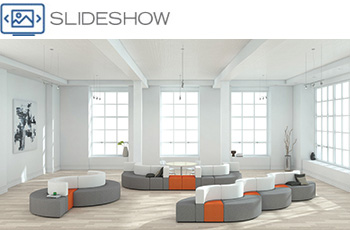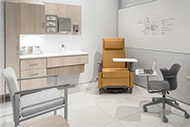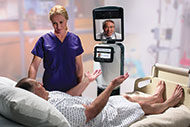Designers and manufacturers report that in today’s health care market, where people have more information, more choices and more responsibility for their own care, individuals are shopping more carefully for health care providers, rather than relying almost solely on their insurance carrier’s directives when selecting doctors and hospitals.
To respond to consumer needs, the public spaces of health facilities are being designed to encourage healthy behaviors and create a more comfortable environment for patients, visitors and staff. “The design of that space really does play out significantly” in consumer satisfaction, says Randy Fiser, CEO, American Society of Interior Designers (ASID), Washington, D.C.
You may also like |
| Planning hospital public spaces |
| Designing spaces for multiple generations |
| Retail influences and impacts on health care |
| |
Furnishings durable and flexible enough to be used in a variety of ways, convenient access to outlets for charging personal electronic devices and hand-hygiene stations designed for public use contribute to the outcomes and experience health care consumers are seeking.
New expectations
“Consumers are shopping [for health care] as they would for anything else,” says Gary Cruce, director of product development for furnishings manufacturer Nemschoff Inc., Sheboygan, Wis. He notes that it can be difficult for hospitals and health systems to differentiate themselves competitively from those providing similar health care services. “So it comes down to how that service is delivered,” he says.
In many health care situations, “[making] the experience better by making it shorter isn’t really an option,” says Cruce. One way providers can improve the experience of waiting in health facilities is to furnish convenient access to power outlets. “Personal electronic devices have really changed the landscape, and they’re impacting health care significantly,” Cruce says. “We see our customers wanting outlets in everything so people can plug their phones in.” Integrated power is an optional feature of Nemschoff’s Easton seating line, for example.
In addition, furniture design, space planning and programming are coming together to create public spaces that can meet a variety of people’s needs, from individuals who want privacy and quiet to families who want to sit together in larger groups. The latest furnishing systems are more diverse than previous systems and can be arranged a number of different ways. Cruce says this is new thinking for hospitals, which conventionally have not wanted people to rearrange the furniture in public spaces; it’s also an approach that may be more suited to such areas as surgery rather than the emergency department. Nemschoff has plans to release new product lines next year that are designed to address “this fundamental shift in how health care is being planned out and delivered. There’s definitely an increase in the consumer-driven point of view,” says Cruce.
Steve Cohen, corporate vice president, sales and marketing, for furnishings company CFGroup, Newport, Tenn., says “for health care facilities in general today, the expectations are different than they once were.” The entire health care market is impacted by an ever-changing competitive front, he says. “If you have a hospital that has a nice environment 15 miles west of you, and a rundown medical center two miles away, you’d have to be in pretty bad shape not to make that extra 13-mile drive.”
Cohen says public spaces articulate the core values of a health care organization and should indicate that people are welcome and will be made comfortable even if they are going to be at the facility a long time.
He notes that well-designed dining areas, in particular, can be important to health care organizations, since food service environments can serve as profit centers. Offering a variety of seating options, such as booths, individual bar-height seating and tables where groups can dine together, divides a large open space into smaller, quieter zones that can make people feel more at ease. CFGroup products are available in a number of designs, like the low-profile Fifth Ave., the high-back Wellington or the bar-height Newbury, all Falcon-brand booths. Convenient access to power outlets is important, Cohen says. “When power is thought about and made part of the experience … it just says to the customer that they’re welcome here and they’re welcome to use the power outlet.
“Technology drives so much in the way people sit and relax and interact now,” he adds. He notes that while this is based primarily on the learning and social styles of millennials, these have been adopted across generations. Catering to personal technology use “is part of the expectation today,” Cohen says.
To keep interiors fresh over time, even as facility needs or consumer preferences change, hospitals and health systems can choose modular furnishings, such as the Moss line by CFGroup’s Thonet brand.
Deborah Breunig, R.N., EDAC, vice president, health care market, for furnishings manufacturer KI, Green Bay, Wis., says it’s important to consider a facility’s future state to specify products that won’t become out-of-date or no longer useful for consumers. KI’s Affina collection is designed to give facilities the flexibility to resize or rearrange lounge spaces as needed. This flexibility extends to users who can move the pieces to obtain privacy or create a space for group discussion.
The Affina line offers integrated power in a traditional seating style, while KI’s MyWay and Hub products are more contemporary modular furnishings designed to support technology use. The company’s new Soltice Metal collection has a simple, modern profile designed for versatility.
Breunig notes that while facility managers have always taken an interest in the patient experience, this has recently become an important health care measurement. Hospitals are required to conduct the federal HCAHPS survey, which records consumer assessments of hospital care and environments; other patient satisfaction surveys, like those administered by performance improvement firm Press Ganey Associates Inc., South Bend, Ind., are widely used, too. “So you have an HCAHPS survey, you may have Press Ganey as another survey — everything is about satisfaction and the experience,” Breunig says.
Public engagement
Hospitals and health systems also can use the design of public spaces to promote healthy behavior. Installing hand-hygiene stations in public areas encourages their use and helps consumers to understand how important infection prevention is to a health care organization.
“Hand hygiene has been studied among health care workers for years, but visitors can also be a vector of germ transmission. Health care environments, more and more, are trying to make their commitment to hand hygiene visible and engage the public in hand hygiene to create a safer environment for their patients. This is where product placement and familiar brands can help,” says Dave Mackay, vice president, sales and marketing, health care, for skin health and hygiene solutions company GOJO Industries, Akron, Ohio, inventors of Purell hand sanitizer.
He says that by putting dispensers at the entrance to the facility, in waiting areas and lobbies, near elevators and in cafeterias, “hospitals are sending a message to all visitors, families and patients: ‘Hand hygiene is not only important to us, it is important for you to practice to help keep your loved ones safe while they’re in a health care facility.’”
Megan DiGiorgio, R.N., CIC, clinical specialist, GOJO Industries, adds, “When you’re placing a dispenser front and center, you’re sending a message that hand hygiene is important.” She notes that people often feel helpless when their loved one is undergoing a medical test or has been admitted to the hospital. “Hand hygiene is one small thing they can do to help contribute to making the patient better,” she says.
“When you see a [sanitizer] dispenser on the wall in a public setting, it clearly communicates a commitment to hand hygiene and that you’re invited to participate,” says Mackay.
In addition to touch-free and manual dispensers, GOJO Industries manufactures a wellness stand that incorporates other aspects of what the company calls respiratory hygiene, or cough etiquette. A wellness stand can include alcohol-based hand rub, facial tissues and surgical masks, as well as hospital signage about infection control. “It’s one thing to educate a family and patient about the importance of hand hygiene. It’s another thing to do that and make products available to them in a way that empowers them to join the fight against infection,” says Mackay.
Ecolab Healthcare North America, St. Paul, Minn., also offers a full range of hand-hygiene solutions for health facilities. Kurt Bogaard, director of marketing, infection protection, Ecolab, says that while most of the company’s dispensers are attractive enough to use in public areas, these areas do not always have a suitable place to install a wall dispenser.
For this reason, Ecolab has developed a cough station, which includes spaces for facial tissues and disposable gloves, and a sanitizer stand meant specifically to be used in such open spaces as lobbies and waiting areas. These products have inserts for customizable graphics that can be branded for a specific hospital or health system. “They can put in very specific messaging about what their goals are in terms of hand hygiene or how important it is for them that guests at their facility are following proper hand-hygiene practices,” Bogaard says.
The Ecolab hand-hygiene system includes additional signage, like table tents designed to be placed throughout the public spaces of a facility to remind people about the importance of washing or sanitizing their hands. “It makes the patients or the guests to that facility feel a little more comfortable that they’re at a place that’s paying attention to all of the different ways to promote healthy outcomes,” says Bogaard.
Selective consumers
Fernando Arias, director of strategic initiatives, ASID, says that with people actively choosing providers, services and program plans on health care marketplace exchanges, “they’re becoming more demanding of value on their investment.”
“They are being more selective,” says Breunig, of KI. “We have a consumer base that is very much aware of having options.” Public spaces designed to help people feel comfortable and safe communicate to discerning consumers that quality care and quality outcomes are important at a facility.
Links to vendor resources
Below are links to the vendors who were covered in this article, in order of appearance:
Nemschoff Inc.: www.nemschoff.com
CFGroup: www.commercialfurnituregroup.com
KI: www.ki.com
GOJO Industries: www.gojo.com
Ecolab Healthcare North America: www.ecolab.com/industry/healthcare






